NeilMed® NasaFlo® Neti Pot: Neti-Pot or Neti-Not? A Review on the Allergic Rhinitis Treatment
It is very likely that at some point in your life, you have experienced allergic rhinitis or searched for a treatment (Side note: Rhinitis is pronounced “rai·nai·tuhs“). Allergic rhinitis, commonly known as hay fever is an allergic reaction causing a runny-nose, nasal itching and sneezing or stuffy nose. Allergic rhinitis is a major culprit that is causing world-wide congestion!
Stat: Approximately 10% to 20% of the global population suffers from allergic rhinitis[1]
FAST FACT: Although ‘Hay Fever’ is another name for allergic rhinitis, it develops when the body’s immune system reacts to something in the environment and has nothing to do with hay or having a fever!
Having nasal symptoms from allergies can be very uncomfortable and disruptive to your day. A common over-the-counter solution is the NeilMed NasaFlo Neti Pot. You may have come across it in your search for a sinus congestion solution or heard about it online, through friends or even from a featured on a segment of Oprah with Dr. Oz back in 2007.
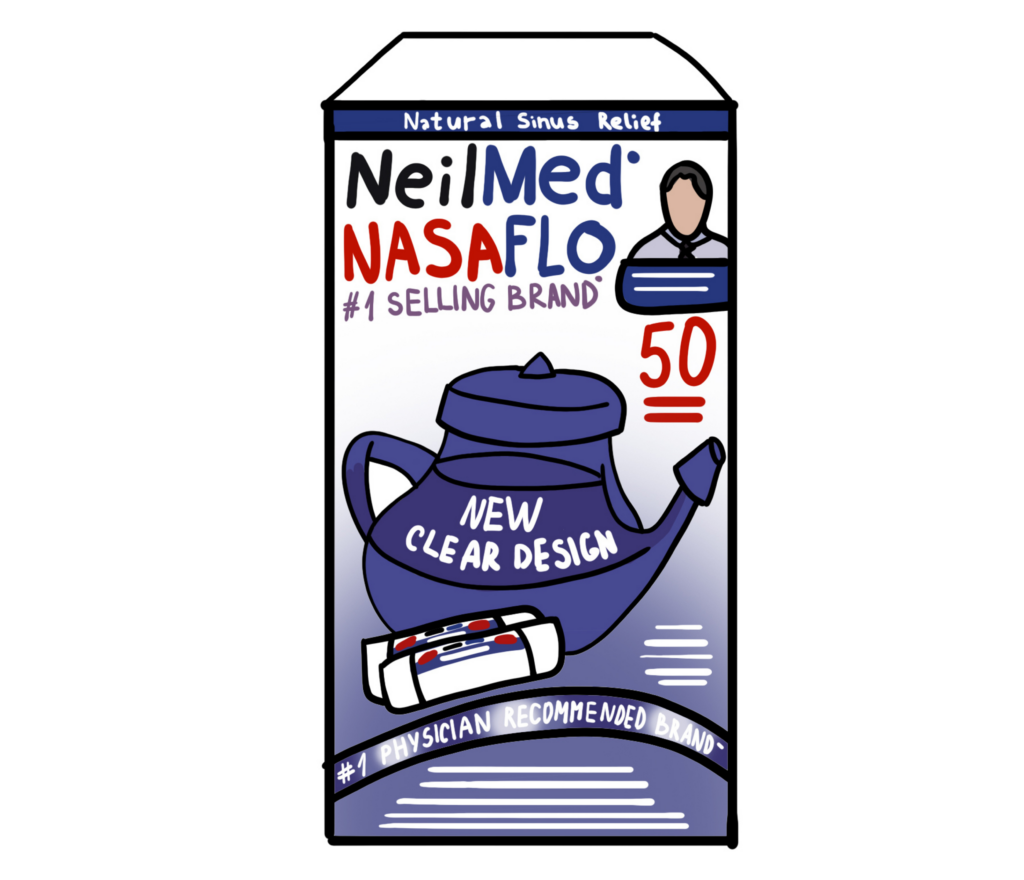
This article will really dig into whether the NeilMed NasaFlo Neti Pot really helps with the nasal symptoms from allergic rhinitis. We will answer your questions around:
What is The Neti Pot Used For?
On The NeilMed Website, it says that the NasaFlo Neti Pot can be used for[2] nasal allergies and relieve sinus pressure from hay fever as well as:
- Nasal dryness
- Nasal stuffiness from cold and flu
- Nasal irritation from dust, fumes, animal dander, grass, pollen, smoke (etc)
- Post nasal drip
- Nasal congestion
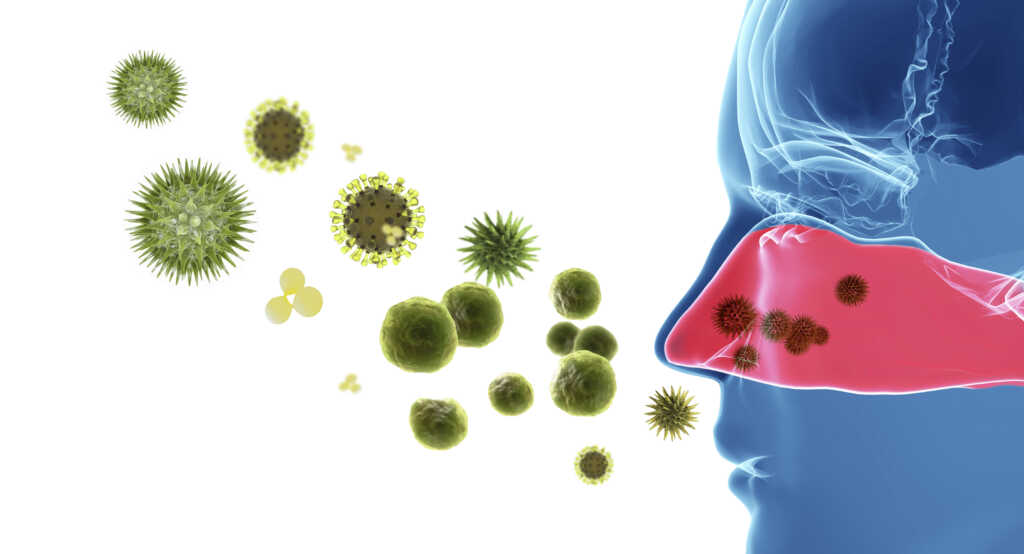
Although the Neti Pot can be used for different conditions all related to the nasal and sinus cavity – we will specifically dig into whether or not it’s an effective treatment for the nasal symptoms allergic rhinitis (ie runny nose, blocked nose, itchy nose and sneezing).
What is a Neti Pot?
The Neti Pot is a nasal irrigation system, a term used for rinsing the nose with a saline (which is a salt water solution). The NeilMed NasaFlo Neti Pot can come in a plastic or ceramic container that is shaped like a teapot or a genie lamp making it easier to pour the salt water solution directly into the nostril[2]. Neti Pots usually come with single use packets of a salt mixture or you can buy the salt packages separately. These packages are then mixed into distilled or purified water.
How Does a Neti Pot Work?
The Neti Pot uses the flow of gravity to flush out the nasal cavity with a large amount of saline water. As you pour the saline solution into one nostril, it enters the sinus cavity and then the flows out of the other nostril. The precise way in which the saline solution helps helps the nasal cavity function better isn’t entirely clear but it is thought to do three things[3] :
- direct cleaning of the nasal cavity
- wash out dirt and mucus and things that could trigger allergies, such as pollen, mold spores, and dust
- improves mucociliary function (these small hair-like structures that help clean out mucus and contaminants!)
How Often Should you Use a Neti Pot?
The Neti Pot can be used daily or whenever there are symptoms. It has been found to be safe if used multiple times a day[4].
TIP: the Neti Pot should be used while bending over a sink or in the shower
Is The Neti Pot An Effective Treatment for Allergic Rhinits?
Nasal Irrigation System as a Treatment for Allergic Rhinitis
We took a good look at the evidence and we found that overall, it has been found to benefit people suffering from allergic rhinitis[5]. It can be used alone in people with mild symptoms or in combination with other medications such as nasal sprays and antihistamines[3]. When used as a single treatment (without other medications) it showed improvement in symptoms that it is well tolerated[6]. It can also be used safely in both children and pregnant women.
Nasal Irrigation in Children
The use of nasal irrigation in children with allergic rhinitis improved runny nose, congestion, throat itching, sleep quality, air flow and also improved quality of life[7][8]. There is also some benefit to reduce inflammation[9].
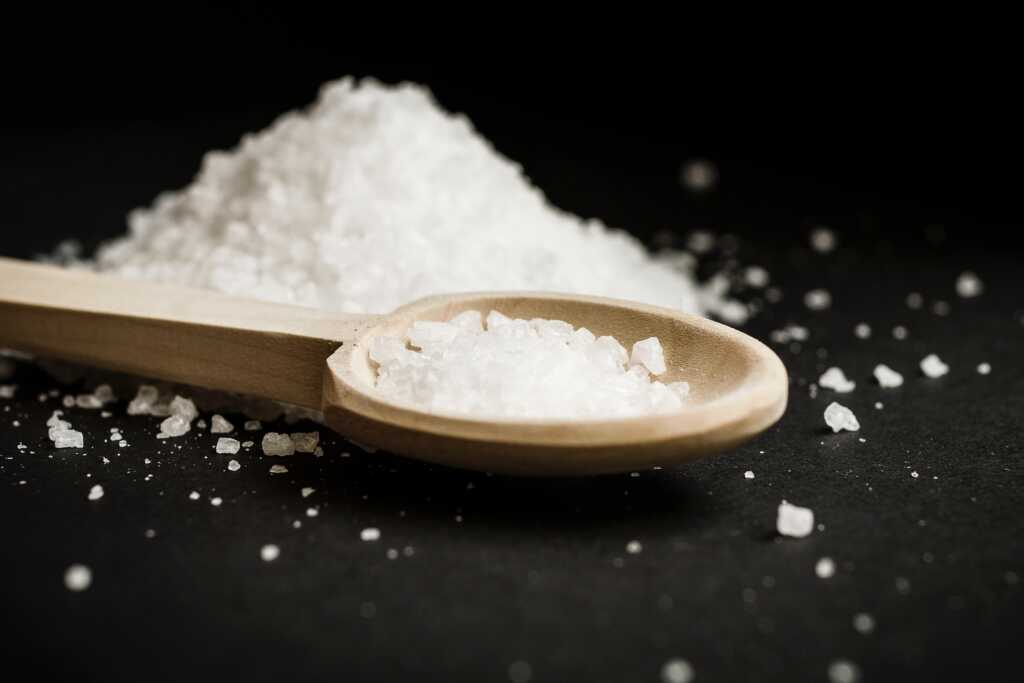
Nasal Irrigation in Combination with Antihistamines
In people taking antihistamines for allergies, there was greater benefit when they also added the use of a saline nasal irrigation system (like the neti-pot) rather than taking antihistamines alone[5].
Nasal Irrigation Versus Intranasal Corticosteroids
Compared to an intranasal steroid spray, the steroid spray is better in improving congestion and nasal symptoms versus saline nasal irrigation[6][10].
Saline Concentrations in Nasal Irrigation Systems
When it comes to the concentration of salt solutions, the evidence is not very clear. Some studies use a higher salt concentration to show further benefit while others say they are equally effective[6][8]. If you’re not clear on what concentration you should use, it is best to discuss this with a health care professional.
An isotonic saline solution (usually using only 1 packet of saline) has a lower salt content and a hypertonic saline (usually using 2 packets of saline) has a higher concentration.
Some Limitations With the Available Studies of Saline Nasal Irrigation as a Treatment Option for Allergic Rhinitis
Some limitations of the available studies are they short term (maximum duration has been three months) and don’t really clarify what device is being used for nasal irrigation. There are a few different devices on the market and the NeilMed NasaFlo Neti Pot is just one of them.
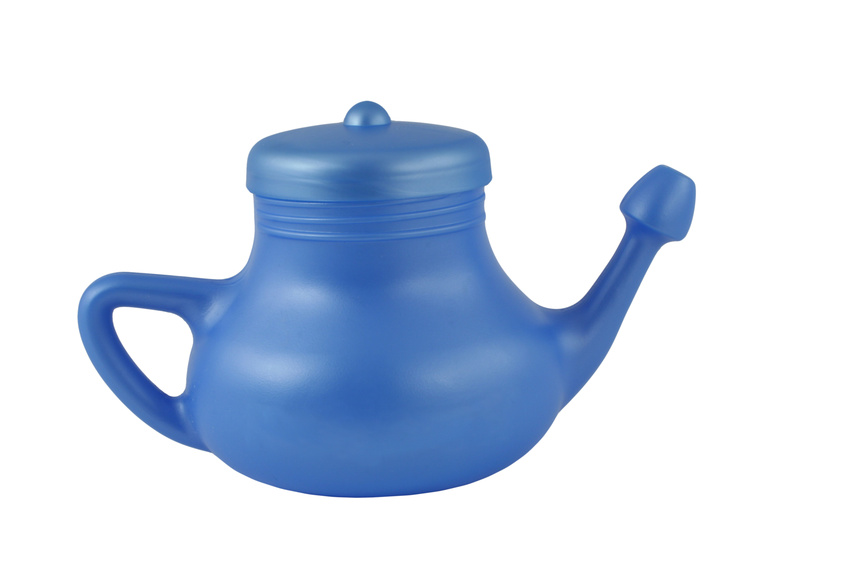
Can Neti Pots Be Used During Pregnancy?
Yes, studies during pregnancy have shown they are safe to use (used up to three times a day). In fact, using neti pot may help reduce the amount of oral antihistamines taken to reduce the allergic rhinitis symptoms[11].
Are There Side Effects from Nasal Irrigation?
For the most part, the Neti Pot is deemed safe, well tolerated and can be used in both children and during pregnancy[5][12].
Some minor adverse effects that have been reported are discomfort and nervousness before first time use (which is completely understandable!). Adverse events appear to be reported in less than 10% of users and include temporary feeling of ear fullness, ear pain, stinging in the nasal cavity or nosebleeds[3][5].
To avoid side effects and infection, it is very important to use distilled, sterile, or boiled water that has cooled to body temperature[12].
What About the Deaths from Neti Pots?
There have been a small number of reported cases of deaths from amoeba infections due to nasal irrigations with neti pots[12][13][14].
Two cases were from the amoeba Naegleria fowleri which is commonly found in lakes, rivers and hot springs[14]. A another case was from the amoeba Balamuthia mandrillaris[13]. In all reported cases, tap water was used that was infected with the amoeba. The type of infection is quite rare and can occur when people get water up the nose from swimming or diving in lakes or rivers. The amoeba can travel from the nose into the brain that causes a disease cause meningoencephalitis (a disease that destroys the brain tissue).
It is not common for amoebas to enter tap water, it can happen – and in most cases the stomach acid kills the amoeba, so drinking contaminated water won’t cause an infection. This disease is rare, but because of this risk, it is important that you use distilled, sterilized or previously boiled water and avoid using tap water.
FAST FACT: Water from ‘water bottles’ don’t necessarily mean
they are distilled. Distillation is a process where water is heated past its boiling point and then condensed from a vapor back into a liquid.
Tips For Using Neti Pots
- Aim the water stream toward the back of your head, not the top of your head.
- The saline solution should flow from one nostril and out the other. It’s okay if you swallow a small amount.
- The burning sensation you may feel the first time should likely go away after the first few times you use it.
- Gently blow your nose after all the solution has drained out to make sure you get rid of some extra water that may be trapped.
- If some water gets trapped in your sinuses, bend forward and look upwards to one side and then the other (as if you are “looking under the sink”)
- If you are using other topical nose sprays, use the Neti Pot before you use any other nose sprays
- Clean the Neti Pot after each use to ensure there is no bacteria growing and it stays clean
TIP: It is a good idea to use a dishwasher safe NetiPot and make sure to clean the product after each use!
Bottom Line
Overall, the NeilMed NasaFlow Neti Pot is a safe and relatively inexpensive option for allergic rhinitis. The Neti Pot won’t treat the underlying causes of allergic rhinitis but it can be used as a treatment to relieve some of the symptoms. From the small studies that have been done, it has shown to improve symptoms such as runny nose and congestion. It is also safe to use in children and during pregnancy. If you are already using an anthistamines or an intranasal spray – the neti pot can used along side if you are not getting enough relief. Make sure to use distilled, sterile or boiled water that has been cooled. Avoid using tap water!
Where Can I Buy The NeilMed Neti Pot in Canada?
In Canada, this product can be bought in-person from any pharmacy or drug store or online from:

Authors:
Brandon Christensen, Bianca Maginnis Castro, Carly Maxwell, Dana Moynihan, Tatianne Pomerleau-Mahe, Vincent Spurrell, Alysha Young
Faculty of Pharmacy and Pharmaceutical Sciences
University of Alberta
Edited and Reviewed by the Health Aisle Team
References
1. Stewart, M., Ferguson, B., & Fromer, L. (2010). Epidemiology and burden of nasal congestion. International journal of general medicine, 3, 37–45.
2. NeilMed Pharmaceuticals NetiPot. (2014). NeilMed NasaFlo NetiPot. Retrieved from http://shop.neilmed.com/Products/NasaFlo-Neti-Pot/NasaFlo-Neti-Pot-New-Clear-Design
3. Rabago, D., & Zgierska, A. (2009). Saline nasal irrigation for upper respiratory conditions. American family physician, 80(10), 1117–1119.
4. UptoDate. (2019). Patient education: Rinsing out your nose with salt water (The Basics). Retrieved from: https://www.uptodate.com/contents/rinsing-out-your-nose-with-salt-water-the-basics
5. Rabago, D., & Zgierska, A. (2009). Saline nasal irrigation for upper respiratory conditions. American family physician, 80(10), 1117–1119.
6. Harvey R, Hannan SA, Badia L, Scadding G. (2007). Nasal saline irrigations for the symptoms of chronic rhinosinusitis. Cochrane Database of Systematic Reviews, Issue 3. Art. No.: CD006394. DOI: 10.1002/14651858.CD006394.pub2.
7. Wang YH, Yang CP, Ku MS, et al. (2009). Efficacy of nasal irrigation in the treatment of acute sinusitis in children. Int J Pediatr Otorhinolaryngol, 73(12), 1696-1701. https://doi.org/10.1016/j.ijporl.2009.09.001
8. Wang, Y., Ku, M., Sun, H. & Lue, K. (2012). Efficacy of nasal irrigation in the treatment of acute sinusitis in atopic children. Journal Of Microbiology, Immunology And Infection, 47(1), 63-69 https://doi.org/10.1016/j.jmii.2012.08.018
9. Khianey, R. & Oppenheimer, J. (2012). Is nasal saline irrigation all it is cracked up to be? Annals Of Allergy, Asthma & Immunology, 109 (1):20-28. doi: 10.1016/j.anai.2012.04.019.
10. Madison, S., Brown, E. A., Franklin, R., Wickersham, E. A., & McCarthy, L. H. (2016). Clinical Question: Nasal saline or intranasal corticosteroids to treat allergic rhinitis in children. The Journal of the Oklahoma State Medical Association, 109(4-5), 152–153.
11. Garavello W, Somigliana E, Acaia B et al. Nasal Lavage in pregnany women with seasonal allergic rhinitis: a randomized study. (2010). Int Arch Allergy Immunol. 151(2):137-41. doi: 10.1159/000236003
12. UptoDate. (201). Pharmacotherapy of Allergic Rhinitis. Retrieved from: https://www.uptodate.com/contents/pharmacotherapy-of-allergic-rhinitis
13. Hensley, Laura. (2018). Woman dies from rare brain-eating disease after using net pot. Global News. Retrieved From: https://globalnews.ca/news/4739754/rare-brain-eating-disease-neti-pot/
14. Parker-Pope, Tara. (2012). Rare Infection Prompts Neti Pot Warning. The New York Times. Retrieved from: https://well.blogs.nytimes.com/2012/09/03/rare-infection-prompts-neti-pot-warning/
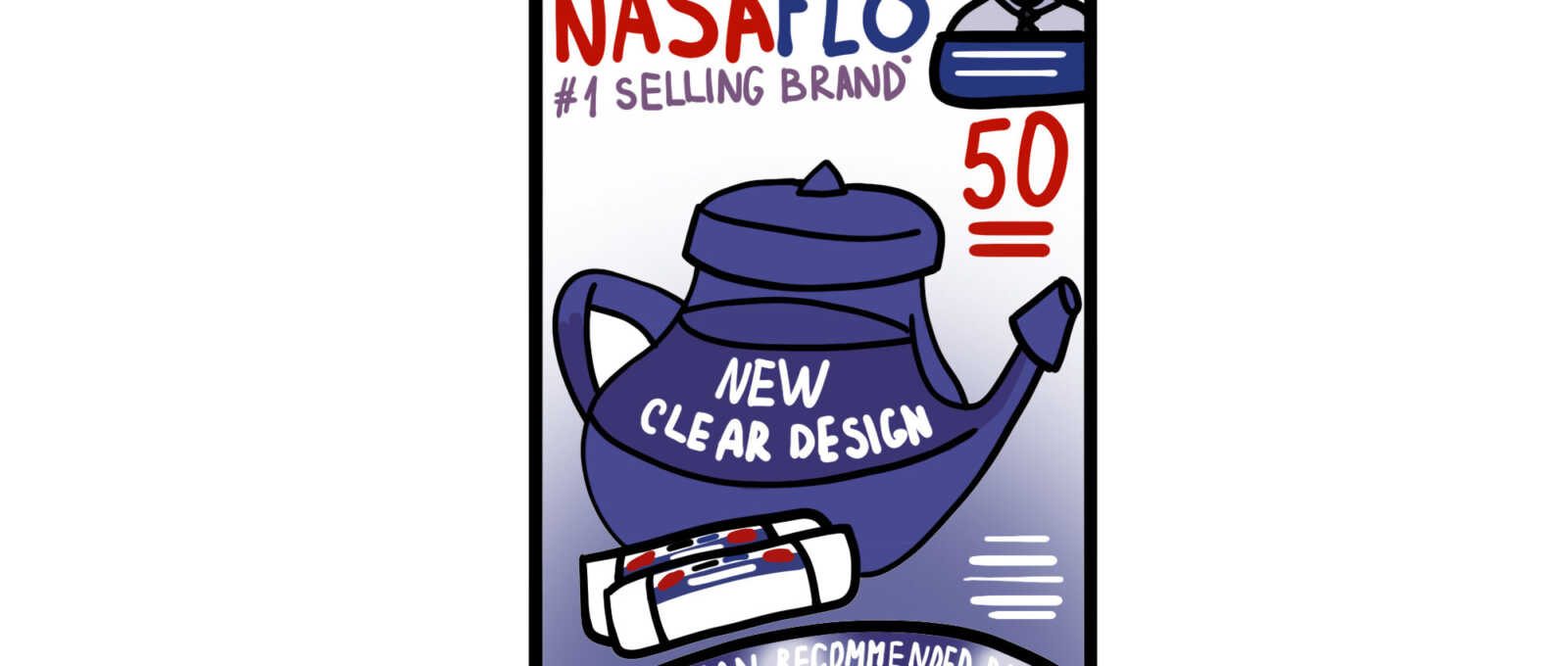
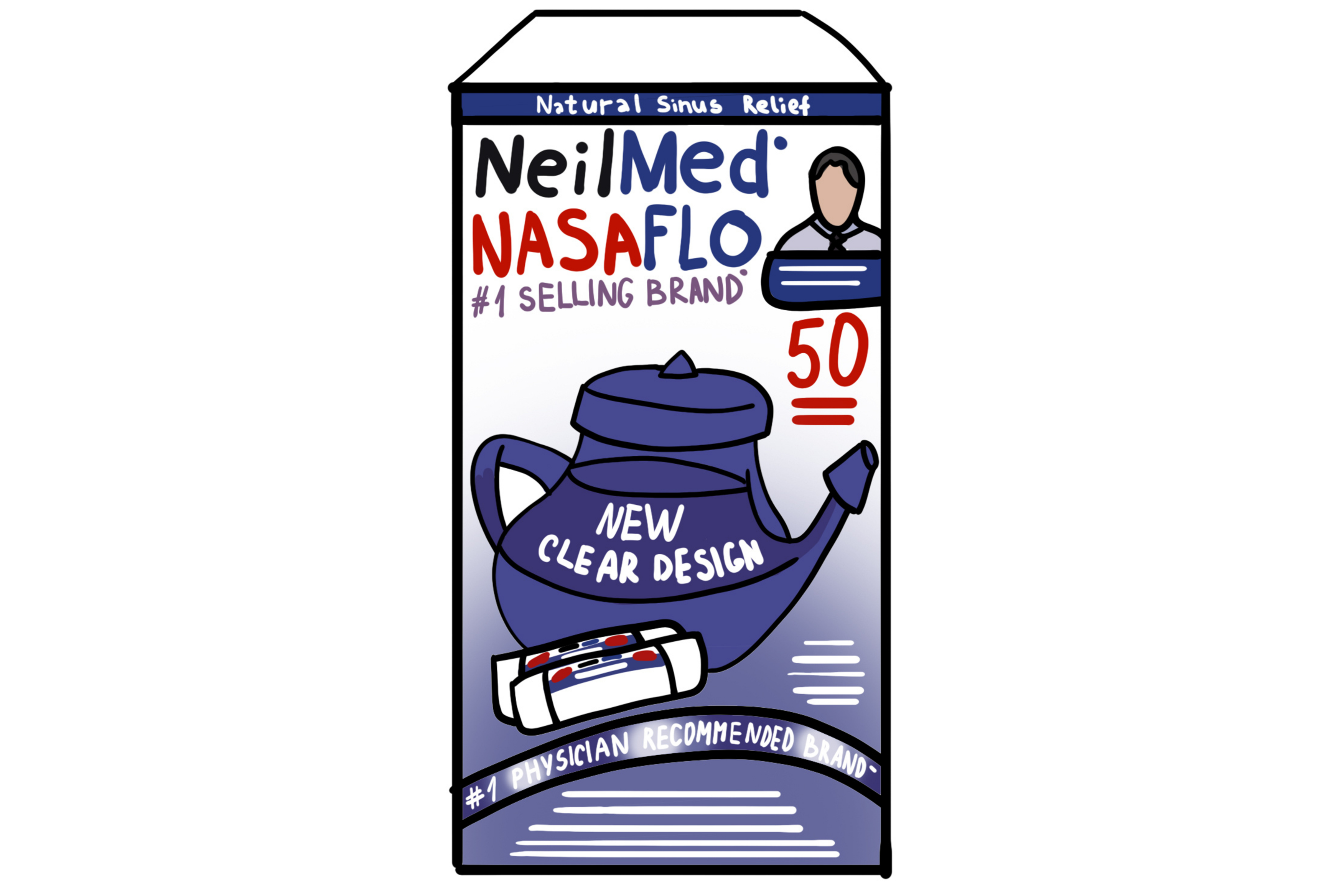


Leave a Comment